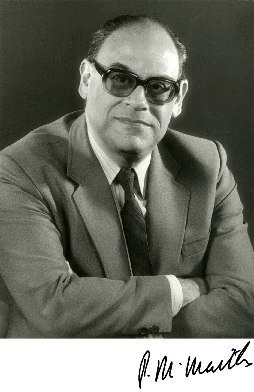Peter Maitlis facts for kids
Quick facts for kids
Peter Maitlis
|
|
|---|---|
 |
Peter Michael Maitlis (born January 15, 1933 – died May 18, 2022) was a British chemist. He was known for his work in organometallic chemistry, which is a special part of chemistry that studies compounds with bonds between a metal and carbon atoms. He was also a Fellow of the Royal Society, which is a very important group of scientists.
Early Life and Education
Peter Maitlis was born on January 15, 1933. He went to Hendon School in north London from 1944 to 1950.
He earned his first degree, a Bachelor's in Science, from the University of Birmingham. Later, he received his PhD in 1956 from the University of London. For his PhD, he studied under Professor Michael J. S. Dewar, who helped create important ideas about how atoms bond in organometallic compounds. Peter Maitlis also earned a higher degree, a DSc, from the University of London in 1970.
Career
After finishing his PhD, Peter Maitlis started working as an Assistant Lecturer at the University of London. He then went to the United States for more study. He was a Fulbright Fellow at Cornell University from 1960 to 1961. After that, he was a research fellow at Harvard University from 1961 to 1962, working with another famous chemist, F. G. A. Stone.
From 1962 to 1972, Maitlis worked and taught at McMaster University in Canada. He started as an Assistant Professor and became a full Professor there. In 1972, he moved back to the United Kingdom. He became a professor of chemistry at the University of Sheffield, where he taught for 30 years. He became an emeritus professor in 2002, which means he retired but kept his title.
In 1971, he wrote two important books about the organic chemistry of palladium. These books were seen as the best guides on how palladium forms special compounds with organic molecules.
Peter Maitlis was chosen as a Fellow of the Royal Society in 1984. This honor recognized his important work on metals like palladium, rhodium, and iridium. These metals are part of the platinum group metals.
Metallomesogens
One of Peter Maitlis's interesting research areas was metallomesogens. These are special metal compounds that can also act like liquid crystals. Liquid crystals are materials that have properties between those of conventional liquids and solid crystals. They are used in things like LCD screens.
Metallomesogens combine the many ways metals can bond with organic molecules with the unique properties of liquid crystals. Maitlis and his team started studying these systems in the mid-1980s. He even created the term metallomesogen himself!
Personal Life
Peter Maitlis was Jewish. He was the father of the well-known journalist and newsreader, Emily Maitlis.
He passed away on May 18, 2022, when he was 89 years old.
Images for kids

